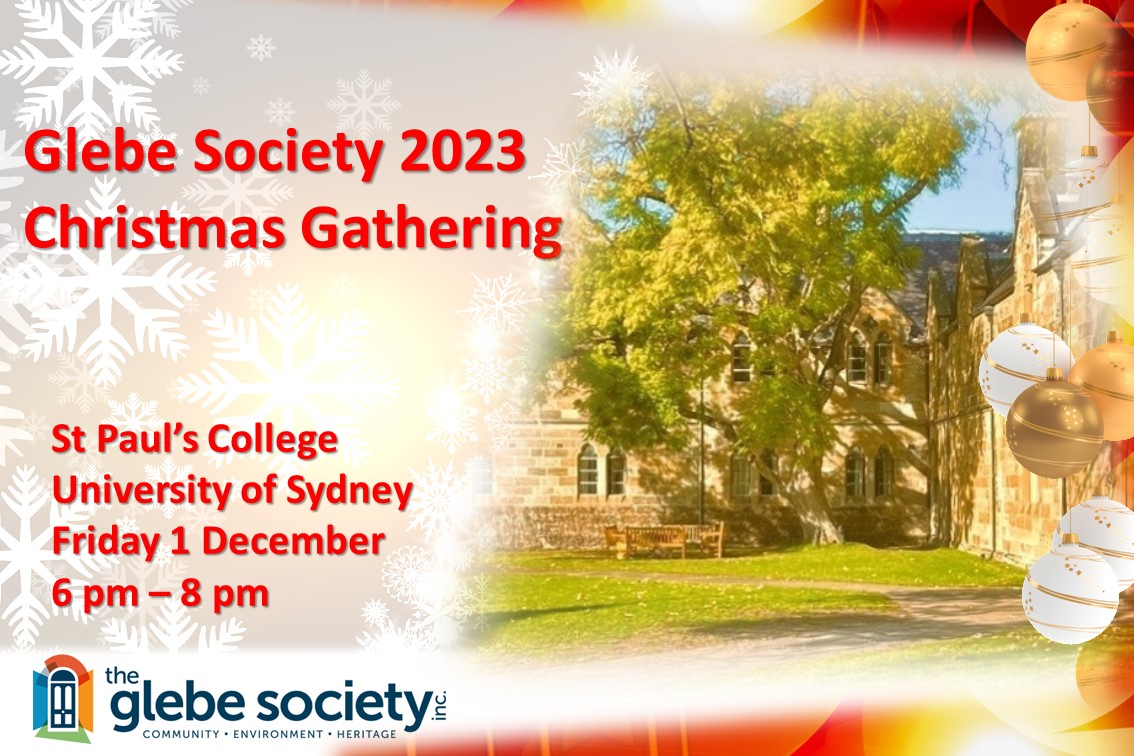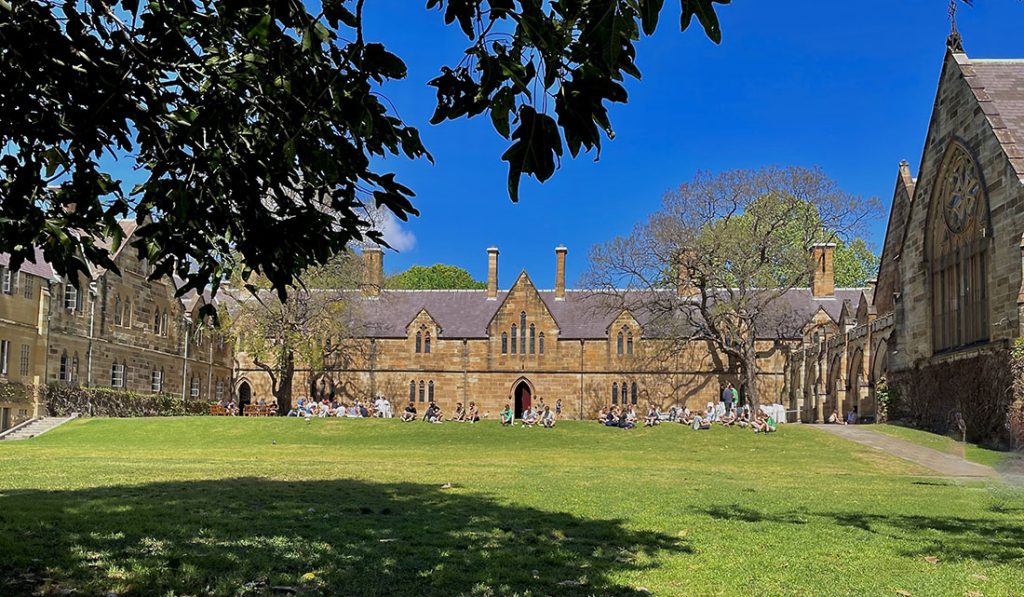By Judy Vergison, Events Convenor, Bulletin 09/2023, November

You’re invited to join us at the Society’s 2023 Christmas gathering at a venue with a special connection to Glebe for over 160 years! It’s being held at the historic St Paul’s College at the University of Sydney on Friday 1 December from 6 pm to 8 pm. St Paul’s is located at 9 City Road, Camperdown (near Carillon Avenue) in the grounds of the University. Members, neighbours, friends and family are all welcome to attend.
The College’s impressive neo–gothic dining hall and facilities were completed in 1859. Our function will be in the junior common room (designed by Glebe architect Edmund Blacket) which flows out to the sandstone cloisters and elegant grassed quadrangle. On the day, signs will be in place from the City Road entry to guide you past the oval and into the College quadrangle.
St Paul’s history tour: The College has kindly offered a free short history tour of the St Paul’s by Richard Morgan, their Community Engagement Director. Numbers are limited to the first 25 bookings received, and bookings are essential for the tour which starts at 5.30 pm and finishes at 6 pm. You will see the option to book for the free tour when you make a booking for the Christmas Party.
Tickets for this year’s Christmas Gathering are $75 per person, which includes a generous tasting menu, one welcome drink (red/white wine, sparkling wine, soft drink) after which we move to a ‘card’ bar for extra drinks. Mineral water will be on tap throughout the event.
To book: Please book through Eventbrite by Friday 24 November. Final numbers and payments need to be in by this date. You need to book early, as numbers are limited, and we cannot take late bookings due to catering arrangements. For help with online bookings, contact events@glebesociety.org.au or Judy on 0417 446 425.

Getting there: The 370 bus and other buses run nearby on City Road with a short flat walk to the College. Parking may be available on City Road (near Carillon Avenue) and there may be off-street parking in Victoria Park or in the Broadway Shopping Centre. Limited onsite parking may be available for a few members with mobility issues; use the contact details for Judy above to request this.
St Paul’s College and its connections with Glebe: the early years
By Richard Morgan, St Paul’s College, Community Engagement Director
Governor Phillip and Surveyor Alt probably had no idea that from the plot of land they surveyed in June 1790 … were to spring the buildings of Australia’s first university. I am sure that neither Francis Grose, Joseph Foveaux nor Thomas Laycock, who all had land grants on the present University grounds, would have had the dreams of the establishment of the University buildings on the north-eastern hill and a Church of England College on the south-eastern hill.
– R.V.H. Morgan, The College 1856-1981, The Pauline, No. 79, 1981, p.20
Following the end of the war with Napoleon there were increasing efforts to found a Church of England college in Sydney modelled on the Oxbridge type. St James’ College was founded in 1846, its home was Lyndhurst in Glebe. The College failed within five years and the interested parties swung behind the founding of a university, which was inaugurated in 1852. The government offered the Grose Farm site to the University in 1853, including allotments for a ring of colleges.
The very early beginnings of St Paul’s College are linked to these experiences, but the vision was for St Paul’s to offer all-round learning. From 1851 the ideas were revived and support from gold-rich Anglicans resulted in the formation of a committee.
An act of parliament established St Paul’s College in 1854, guided through the Legislative Council by Charles Cowper, son of the Archdeacon of Sydney, William Cowper (see article below for more on William Cowper). A council of Fellows was appointed in 1855 led by Sir Alfred Stephen, the Chief Justice of NSW and, to comply with the Act, a temporary Warden was appointed. He was the elderly Archdeacon Cowper, ‘unmistakably Evangelical, but he was also universally revered (Alan Atkinson, Hearts and Minds, 2017, p. 67). A new permanent Warden, Rev Henry J. Hose, from England, took up office in 1856.
A foundation stone was laid in a ditch on the site by the NSW Governor Sir William Denison o

n 25 January 1856. It was never incorporated in one of the structures and has been moved several times until its current setting at the Albert Archway outside the College Quadrangle. Between 1857 and 1859 the original building was built in Pyrmont sandstone by a team of stonemasons under the direction of famed architect of the time, Edmund Blacket. He was the architect of the University buildings and lived in Glebe. The first builder was John Dingwall of Woolloomooloo who was replaced by Robert Melville of Glebe in June 1857.
The first handful of students moved into the College on the Grose Farm site in 1858, while the neo-gothic dining hall and facilities were still under construction. They were completed in 1859. Of St Paul’s College, Atkinson wrote: ‘Paul’s was to be a place of shared life, shared learning and shared worship, a pseudo-Benedictine interweaving of labour and prayer, and it was also to teach a good number of subjects not covered on the other hill’ (ibid, p. 87), [the ‘other hill’ being the University].
Fast forward to 2023 and you will find a College in the Anglican tradition of over 400 people living in spacious accommodation created 165 years ago. Since then, the College’s buildings have been added to in the 1880s, pre-WW1, the 1920s, 1940s, 1960s, 1990s and 2010s. With a 2018 Act of Parliament, the head of the College is no longer required to be a Church of England minister. The College boasts a Graduate House for over 130 postgraduates. Over 300 undergraduate men and women live and study under one roof. The College has all the ‘mod cons’ demanded by youth and necessitated by contemporary academic rigour.








There are no comments yet. Please leave yours.